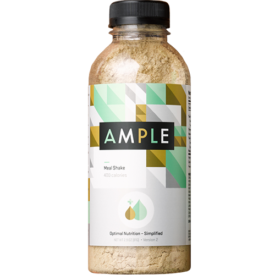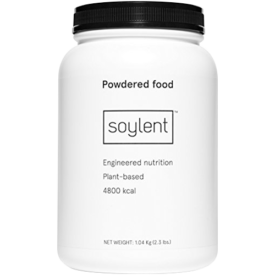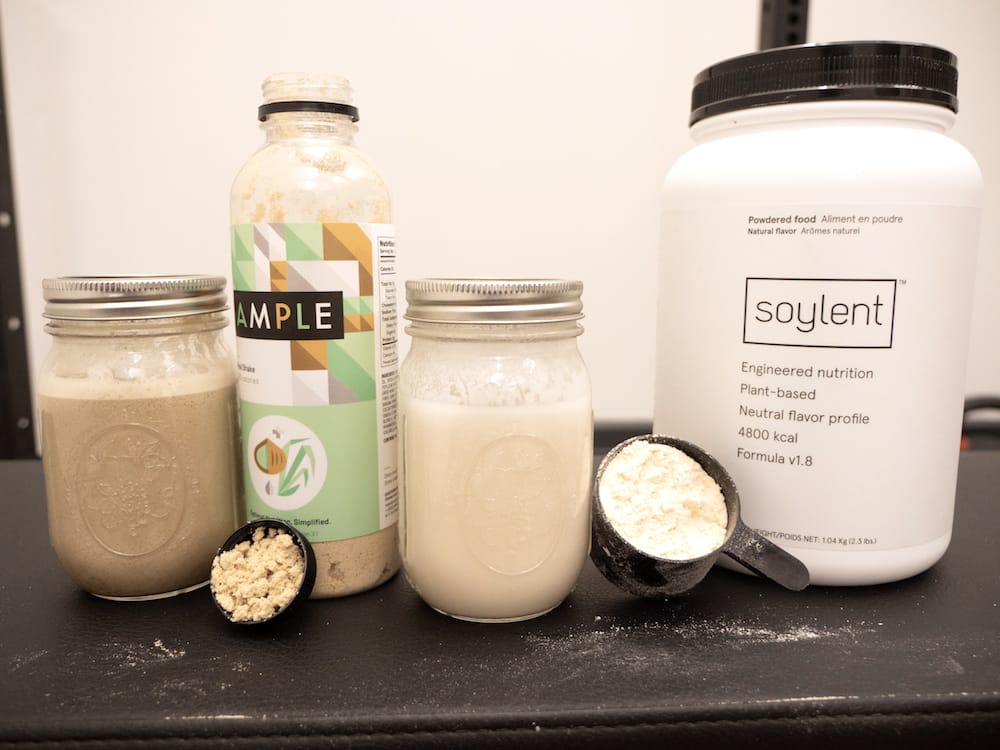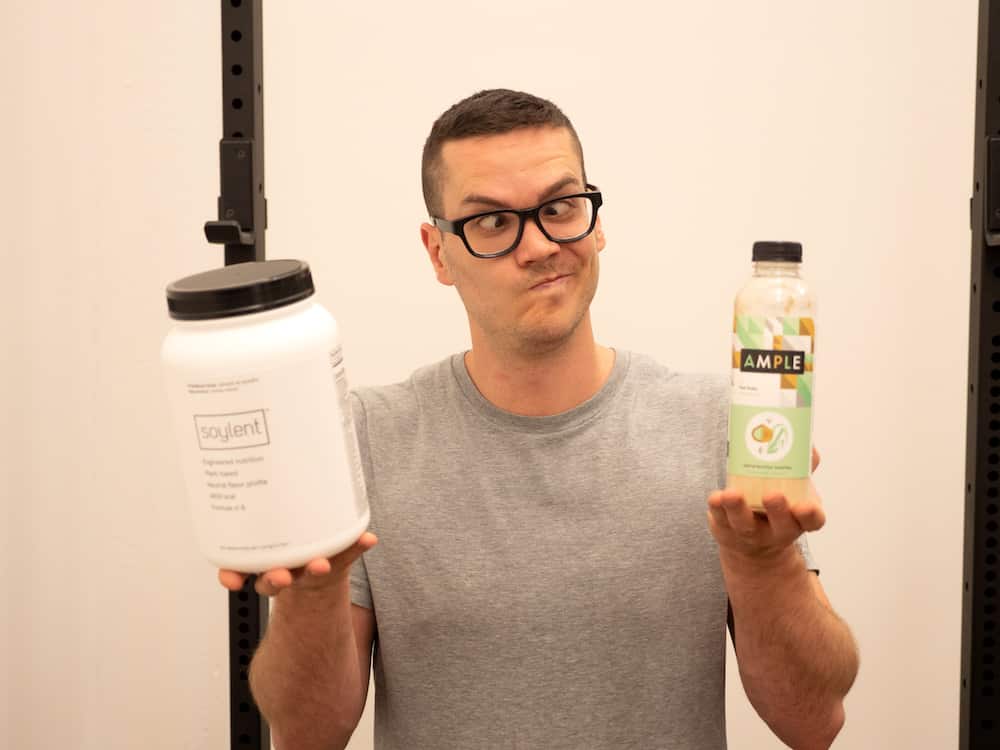Soylent changed the way people think about meal replacements. Targeting techies and busy entrepreneurs, Soylent wanted customers to look at meal replacements as a crucial part of their productivity routine. What if you could cut food prep, eating, and cleanup out of the equation? Despite the founder spending months living on Soylent alone, the company now emphasizes that it shouldn’t replace all your meals — but it can replace any meal. But how does it stack up to Ample Meal, another popular meal replacement supplement?
Ample came hot on the heels of this meal replacement revolution. Launched a couple of year’s after Soylent’s debut, it takes a different approach: instead of delivering a ton of nutrients encased in soy and seed oil, what if we had a super satiating, all-natural meal replacement that improved gut health and delivered antioxidants?
For two products so often compared, they’re extraordinarily different. Let’s take a closer look at Ample versus Soylent.


[Want to know the best meal replacements we’ve tried? Take a look at our full list.]
Ample Vs. Soylent Nutrition
Soylent
One serving of Soylent is two scoops, which comes to 400 calories: 20 grams of protein, 39 grams of carbohydrates (5 grams of soluble fiber, 15 grams of sugar), and 20 grams of fat (1.5 grams saturated, 3.5 grams polyunsaturated, 14 grams monounsaturated, no trans fat).
The micronutrients are super impressive. There’s 20 percent of the recommended daily intake of 21 micronutrients: Vitamins A, C, D, E, K, B6, B12, thiamin, riboflavin, niacin, folate, pantothenic acid, biotin, calcium, iron, potassium, iodine, magnesium, zinc, copper, manganese.
There’s also 10 percent of the RDI of molybdenum, chromium, and choline, and 14 percent of your daily sodium.

Ample
If you’re looking at 400 calories of Ample — the same amount in one “meal” of Soylent — you’ll get 27 grams of protein, 25 grams of carbs (10 grams fiber, 4 grams sugar), and 21 grams of fat (10 grams saturated). Unlike with Soylent, there’s no info about polyunsaturated fats.
[Shop Ample Meal HERE and get 15% off with code BARBEND.]
[Read our full Ample Review.
In stark contrast to Soylent, there are very few micronutrients: 2 percent of your daily Vitamin C, 4 percent of your calcium, 10 percent of your iron, and 21 percent of your sodium. That’s everything.

Ample Vs. Soylent Ingredients
Soylent
Most are the vitamins and minerals themselves but the first ingredients are soy protein isolate, then high oleic canola oil, maltodextrin (a carbohydrate made from starch, usually corn), isomaltulose (a “slow-metabolizing” carb made from beets), soluble corn fiber, and modified food starch.
[Read our full Soylent Review.]
Then the nutrients start, but included in the rest of the ingredients are soy lecithin (for mixability), natural flavor, xanthan gum (for thickening and stabilizing), and the artificial sweetener sucralose (also called Splenda).
Note that Soylent is not only is artificially sweetened but it contains soy, corn, and canola oil. It’s also not gluten free and it contains GMO ingredients.
[Shop Soylent on Amazon HERE.]
Ample
While Ample doesn’t contain many micronutrients, the ingredients are where they make their reputation.
Protein: grass-fed whey concentrate, pea protein, grass-fed hydrolyzed collagen protein
Carbohydrates: Sweet potato powder, tapioca dextrin, organic psyllium husk, chicory root fiber, acacia fiber
Fats: Coconut oil, macadamia nut oil, omega-3 chia extract
Fruits and Veggies: green banana powder, organic wheatgrass, organic barley grass, organic chlorella
Probiotic bacteria: 40 billion from six different strains: Lactobacillus acidophilus, Lactobacillus paracasei, Bifidobacterium lactis, Bifidobacterium infantis, Lactobacillus rhamnosus, Bacillus coagulans.
Flavorings: dried honey, cocoa powder, lemon juice powder, cinnamon, sea salt, natural flavor, monk fruit extract, stevia extract
There are no artificial flavors or ingredients, but it’s also important to note that Ample has a much bigger emphasis on digestive health: it has more fiber and it has all those probiotic bacteria, which have been linked to everything from better immunity to better nutrient absorption.
The fruits and veggies are meant to contain antioxidants, but the product doesn’t go into detail regarding how many antioxidants it contains so you sort of have to take that on faith. On a similar note this product contains an omega-3 extract made from chia seed, but doesn’t mention how many polyunsaturated fats it contains.
Price
Soylent
There are a few options with Soylent. You can buy a 2.3-pound tub for roughly $35, which contains 12 meals of 400 calories (so $2.80 per serving). You can also get it in pouches and while there’s a minimum order of 7 pouches (35 meals), it drops the price to about $1.75 per serving.
Furthermore, you can decrease the price by about 10 additional percent by subscribing to a monthly shipment.
Ample
You need to buy a minimum of 6 bottles of Ample at a time and if we’re still talking about the 400-calorie version, it’s going to come to $5.85 per meal.
The price drops the more you order if you buy 12, 30, or 60 at a time, with a 60-pack costing $4.97 per meal. That’s not quite as cheap as it can get, though, since you can subscribe to regular shipments and save an extra 10 percent. There are also 600-calorie bottles available for roughly $1.30 more per meal.
But the cheapest Ample can possibly get is $4.47 for 400 calories and that’s if you get over $250 worth every month. Soylent is clearly cheaper here.
Taste
Soylent
Despite the artificial sweetener that’s been added, this is not a sweet or flavorful drink. It tastes a lot like plain tofu in liquid form. It might make for a good base for other flavors if you like smoothies and it is available in a tastier Cacao flavor, but the Original flavor of Soylent isn’t that much fun to drink.
Ample
Ample tastes fantastic. Taste is subjective, of course, but the high fat content combined with the whey, cinnamon, cocoa, and dried honey make for a drink that tastes quite a lot like liquid shortbread. If you like buttery cookies, there’s a good chance you’ll like this.
Soylent Vs. Ample
Again, these are very different products.
Soylent is cheaper and more nutritious, though it has more artificial and non-Paleo ingredients, plus it doesn’t taste amazing.
Ample tastes great and has way more ingredients for gut health, but there are few vitamins or minerals and it’s much more expensive.
Either can fit into your meal plan depending on what your goals are. Bottoms up!